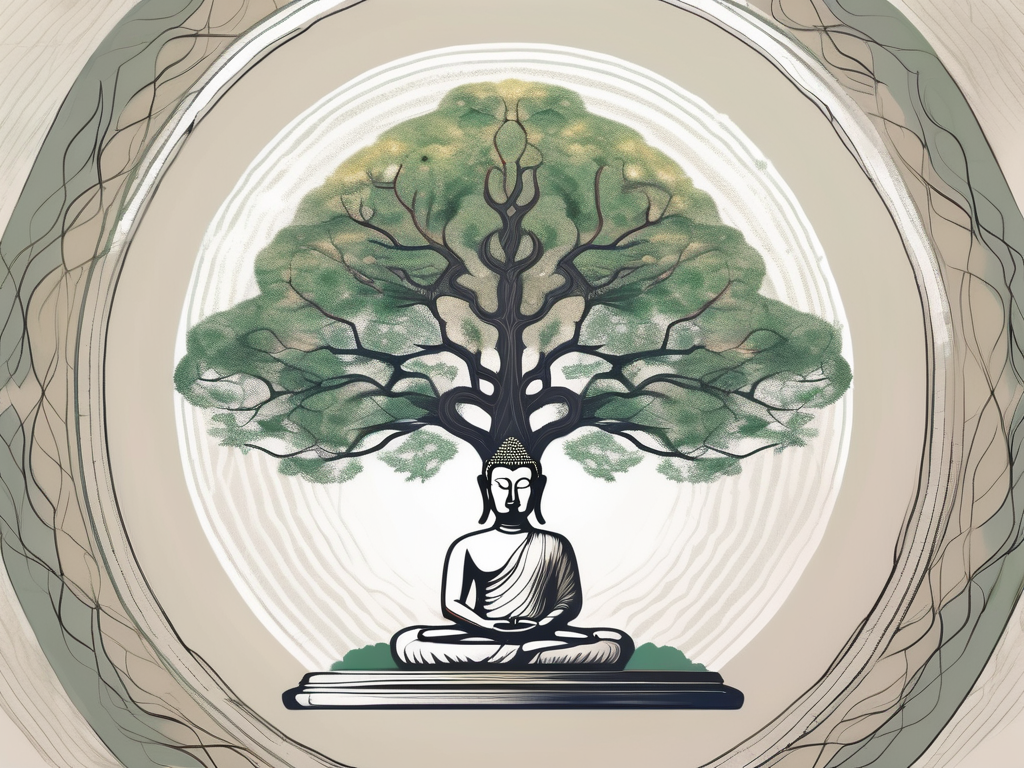Buddhism, one of the world’s major religions, stands as a beacon of enlightenment and spiritual awakening for millions of devotees worldwide. But have you ever wondered about the origins of this ancient belief system? In this article, we will delve deep into the heart of Buddhism, examining its core beliefs and practices, exploring its historical and cultural context, and uncovering the enigmatic date of its birth.
Understanding Buddhism: A Brief Overview
Before we dive into the profound mysteries surrounding Buddhism’s origins, let’s take a moment to familiarize ourselves with the fundamental tenets of this spiritual philosophy. At its core, Buddhism revolves around the notion of nirvana – a state of liberation from suffering and ignorance. Buddha, meaning “the awakened one,” is the central figure in this religion. His teachings, known as the Dharma, emphasize the Four Noble Truths and the Noble Eightfold Path, both of which offer a blueprint for attaining enlightenment.
In order to truly grasp the essence of Buddhism, it is important to explore the rich tapestry of beliefs and practices that make up this ancient tradition. By delving deeper into its core principles, we can gain a greater understanding of the profound impact it has had on individuals and societies throughout history.
The Core Beliefs and Practices of Buddhism
Central to Buddhism is the belief in karma and rebirth. According to this principle, our actions in this lifetime have consequences in the next, shaping our future existence. This concept of cause and effect underscores the importance of ethical living and mindful actions. By cultivating positive intentions and engaging in virtuous behavior, Buddhists aim to accumulate good karma, which can lead to favorable rebirths and ultimately, liberation from the cycle of suffering.
However, the path to enlightenment is not solely dependent on external actions. Buddhists recognize the significance of inner transformation through meditation and mindfulness. By training the mind to be present and aware, individuals can develop insight into the nature of reality and overcome the delusions that perpetuate suffering. Through dedicated practice, one can gradually dissolve the barriers that separate the self from others, cultivating a sense of interconnectedness and compassion.
In addition to these core beliefs, Buddhism encompasses various practices, such as chanting, prostrations, and the offerings of incense and flowers. These rituals serve as expressions of devotion and acts of merit-making, reinforcing the teachings of the Buddha and fostering inner growth. They provide a tangible way for individuals to connect with the spiritual realm and deepen their understanding of the Dharma.
The Significance of Buddhism in World Religions
Buddhism holds a unique place among the world’s religions. While it may not have the largest number of adherents, its impact is felt far and wide. Buddhism’s emphasis on compassion, mindfulness, and self-awareness resonates with people from diverse backgrounds. Its teachings have influenced art, literature, philosophy, and even modern psychology.
Moreover, Buddhism’s emphasis on non-violence and the interconnectedness of all beings has contributed to its enduring appeal. In an increasingly interconnected world grappling with numerous challenges, Buddhism’s teachings offer solace and guidance, providing a pathway towards personal and social transformation. The principles of Buddhism have inspired countless individuals to lead lives of purpose, seeking not only their own liberation but also working towards the betterment of society as a whole.
As we continue our exploration of Buddhism, we will unravel the historical context in which it emerged, examining the life of the Buddha and the spread of his teachings throughout Asia. By delving into the rich tapestry of Buddhist traditions and the diverse cultural expressions it has inspired, we can gain a deeper appreciation for the enduring legacy of this profound spiritual philosophy.
Tracing the Roots: The Birth of Buddhism
Buddhism finds its genesis in the extraordinary life and teachings of Siddhartha Gautama, the first Buddha. Born in the 5th century BCE into a royal family in present-day Nepal, Siddhartha’s journey from prince to ascetic to enlightened teacher is both captivating and transformative.
The Life of Siddhartha Gautama: The First Buddha
Siddhartha Gautama’s childhood was suffused with luxury and opulence, shielded from the harsh realities of life. However, his encounters with suffering – aging, illness, and death – set him on a quest for truth and liberation.
Renouncing his privileged life, Siddhartha embarked on a spiritual journey of self-discovery. He left behind the comforts of the palace, venturing into the world to seek answers to the fundamental questions that plagued his mind. He encountered wandering ascetics, who lived in poverty and practiced extreme self-denial in the pursuit of spiritual enlightenment. Intrigued by their way of life, Siddhartha decided to adopt their practices, believing that such extreme measures would lead him to the ultimate truth.
For six years, Siddhartha subjected himself to severe austerities, enduring hunger, sleep deprivation, and physical hardships. He pushed his body to its limits, hoping to transcend the mundane world and attain enlightenment. However, despite his unwavering dedication, Siddhartha found that extreme self-mortification did not provide the answers he sought. Realizing the futility of this path, he abandoned his ascetic practices and turned towards a middle way.
Underneath the shade of the Bodhi tree, Siddhartha, now the Buddha, embarked on a final meditation. He resolved not to rise until he had achieved enlightenment. As the night deepened, Siddhartha faced numerous temptations and distractions, but he remained steadfast in his pursuit. Finally, at the break of dawn, he attained a state of profound awakening, gaining insight into the nature of existence, suffering, and the path to liberation.
The Cultural and Historical Context of Buddhism’s Emergence
But what were the circumstances that surrounded the birth of Buddhism? Siddhartha’s quest for truth took place in a time of immense socio-cultural change in ancient India. The Indian subcontinent was a melting pot of diverse religious and philosophical ideas, with various schools of thought vying for dominance.
Against this backdrop of spiritual ferment and intellectual exploration, Buddhism emerged as a response to the prevailing religious and philosophical ideas of the time. It challenged the authority of the Brahmin priests and the rigid caste system, advocating for a more egalitarian society where all individuals had the potential to attain enlightenment.
As Buddhism gained popularity, it spread beyond the boundaries of ancient India. It found fertile ground in neighboring regions, such as Sri Lanka, Myanmar, and Thailand, where it blended with local beliefs and customs. Over time, different schools of Buddhism emerged, each with its own interpretations and practices.
The spread of Buddhism was not limited to South Asia. It reached as far as Central Asia, China, and Japan, where it encountered and assimilated with existing religious traditions. In each new cultural landscape, Buddhism adapted and evolved, incorporating local customs and beliefs into its teachings.
Today, Buddhism continues to thrive as a major world religion, with millions of followers around the globe. Its rich history and diverse traditions make it a fascinating subject of study, offering profound insights into the human condition and the quest for spiritual enlightenment.
Determining the Date: Unveiling the Origin of Buddhism
The date of Buddhism’s origin has long been shrouded in mystery and debate. Ascertaining an exact timeline for the religion’s inception has proven challenging due to multiple factors, including the scarcity of reliable historical records and the complex interplay of archaeological findings.
However, the quest to uncover the origins of Buddhism has not been in vain. Over the years, scholars and archaeologists have made significant progress in unraveling the mysteries surrounding the birth of this ancient religion.
Archaeological Evidence and Its Interpretation
Archaeological discoveries have played a crucial role in shedding light on Buddhism’s early history. From the remains of ancient monastic complexes to intriguing inscriptions, these findings provide valuable glimpses into the early development of Buddhist communities.
One such remarkable discovery is the ancient city of Sanchi in India. Excavations at this site have revealed a magnificent stupa, adorned with intricate carvings depicting scenes from the life of the Buddha. These carvings not only offer a visual narrative of the early Buddhist teachings but also provide clues about the artistic styles and cultural influences prevalent during that time.
Another fascinating archaeological find is the Gandhara region, located in present-day Pakistan and Afghanistan. The Gandhara art, characterized by a unique blend of Hellenistic and Indian artistic traditions, showcases the cross-cultural exchange that took place along the ancient Silk Road. The Gandhara sculptures, depicting the Buddha and various Buddhist deities, provide valuable insights into the spread of Buddhism beyond its birthplace.
Interpreting these artifacts, however, requires careful analysis and scholarly consensus. As archaeologists continue to unearth new evidence, our understanding of Buddhism’s origins grows, but many mysteries still linger, waiting to be unraveled.
Historical Records and Their Analysis
Another avenue for uncovering the date of Buddhism’s origin lies in historical records. Ancient texts, such as the Pali Canon and Sanskrit scriptures, offer invaluable insights into the early Buddhist teachings, rituals, and the spread of the religion.
The Pali Canon, a collection of scriptures in the Pali language, is considered one of the oldest and most authoritative sources for understanding the early Buddhist tradition. It contains a vast repository of discourses, rules for monastic conduct, and philosophical treatises that provide a comprehensive view of the early Buddhist community.
Similarly, the Sanskrit scriptures, including the Mahayana sutras, offer a glimpse into the development of Buddhist thought and the emergence of new schools of Buddhism. These texts, written in Sanskrit, the classical language of ancient India, provide a rich tapestry of narratives, parables, and philosophical teachings that continue to inspire Buddhist practitioners to this day.
Yet, deciphering these texts and piecing together an accurate chronology is no easy task. Scholarly debates persist, and differing interpretations of historical records continue to shape our understanding of the birth and early development of Buddhism.
Despite the challenges, the combined efforts of archaeologists, historians, and scholars from various disciplines have brought us closer to unraveling the enigma of Buddhism’s origin. With each new discovery and scholarly insight, the intricate tapestry of this ancient religion becomes more vibrant and captivating, inviting us to delve deeper into its fascinating history.
The Spread of Buddhism: From India to the World
The allure of Buddhism’s teachings transcended geographical boundaries, sparking a captivating journey that carried the religion far beyond its birthplace in ancient India.
The Role of Ashoka the Great in Buddhism’s Expansion
One of the key figures in Buddhism’s spread was Emperor Ashoka the Great, who ruled over the Maurya Empire during the 3rd century BCE. Initially a ruthless and ambitious ruler, Ashoka underwent a transformative experience after witnessing the devastation caused by his military conquests.
Adopting Buddhism’s teachings of non-violence and compassion, Ashoka became a fervent patron of the faith, commissioning the construction of monasteries and pillars bearing edicts related to moral conduct and the principles of Dharma. Through his efforts, Buddhism’s message radiated across the Indian subcontinent and beyond, reaching as far as Southeast Asia.
Buddhism’s Journey Along the Silk Road
Another significant factor in Buddhism’s expansion was the ancient Silk Road, a vast network of trade routes stretching from China to the Mediterranean. Traders, pilgrims, and scholars traversed this extraordinary pathway, carrying not only goods but also ideas from one culture to another.
Along the Silk Road, Buddhist missionaries and merchants disseminated the teachings of Buddhism, establishing monastic centers and contributing to the religion’s growth. As the centuries passed, Buddhism took root in diverse regions, adapting to local customs and giving rise to different schools and sects.
The Evolution of Buddhism: Schools and Sects
Buddhism’s journey through time has witnessed the emergence of various schools and sects, each offering unique perspectives and practices.
Theravada Buddhism: The School of the Elders
Theravada Buddhism, rooted in the teachings of the early scriptures, places a strong emphasis on meditation and monastic discipline. Practiced predominantly in Southeast Asia, Theravada adherents seek to attain enlightenment by following the path laid out by the Buddha himself, nurturing wisdom and self-realization.
Mahayana Buddhism: The Great Vehicle
On the other hand, Mahayana Buddhism emphasizes the ideal of the bodhisattva – individuals who vow to attain enlightenment for the benefit of all sentient beings. Widely practiced in East Asia, Mahayana Buddhism encompasses diverse traditions such as Zen, Pure Land, and Tibetan Buddhism.
Within Mahayana, the idea of emptiness – the profound understanding that all phenomena lack inherent existence – occupies a central role. By realizing the illusory nature of reality, Mahayana practitioners strive to cultivate compassion, wisdom, and a profound sense of interconnectedness.
In conclusion, piecing together the origin of Buddhism remains a complex task, drawing upon archaeology, historical records, and a myriad of scholarly interpretations. Yet, these challenges only serve to pique our curiosity further, inspiring a deeper exploration of the enigmatic beginnings and profound teachings of this ancient and perennial philosophy.












